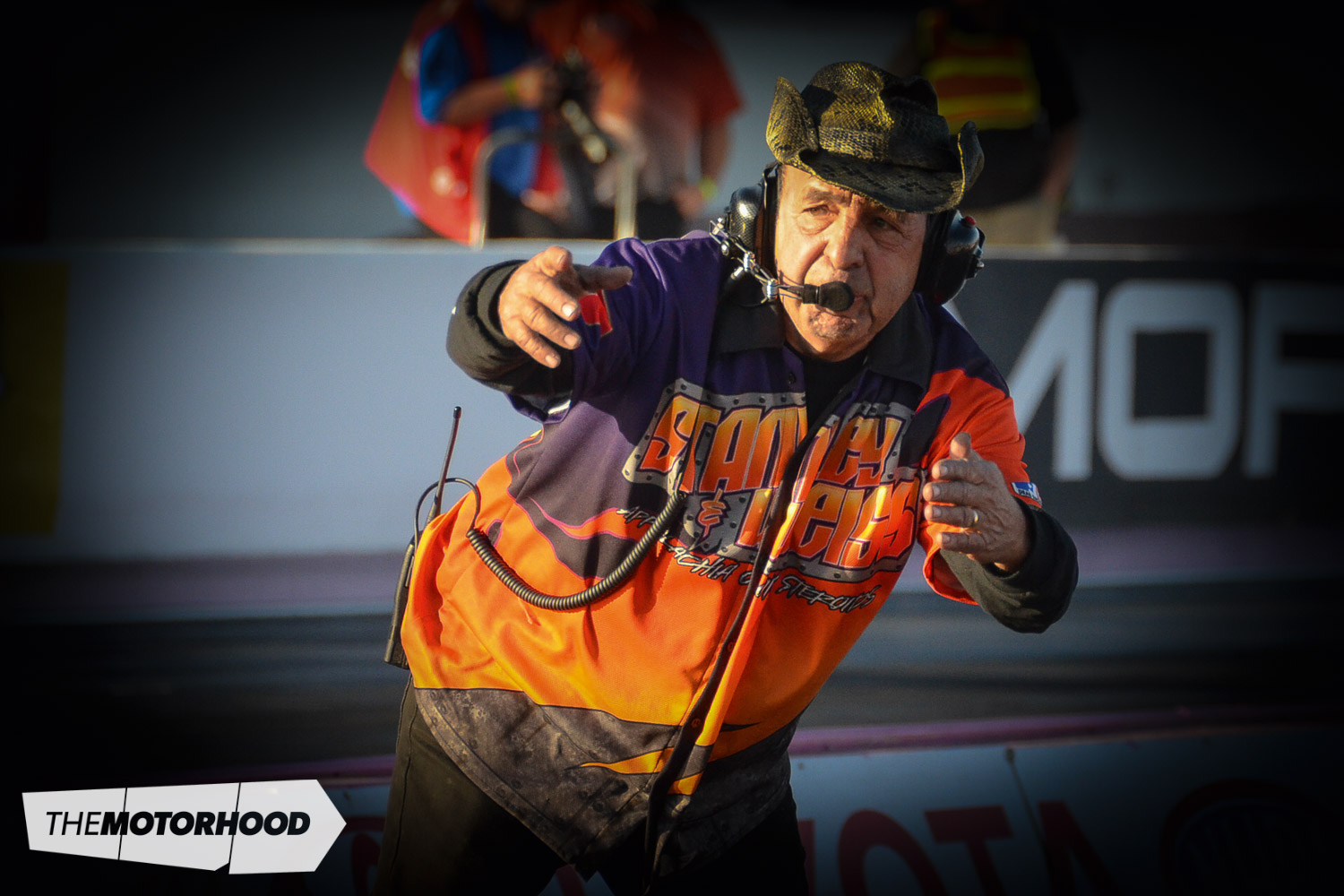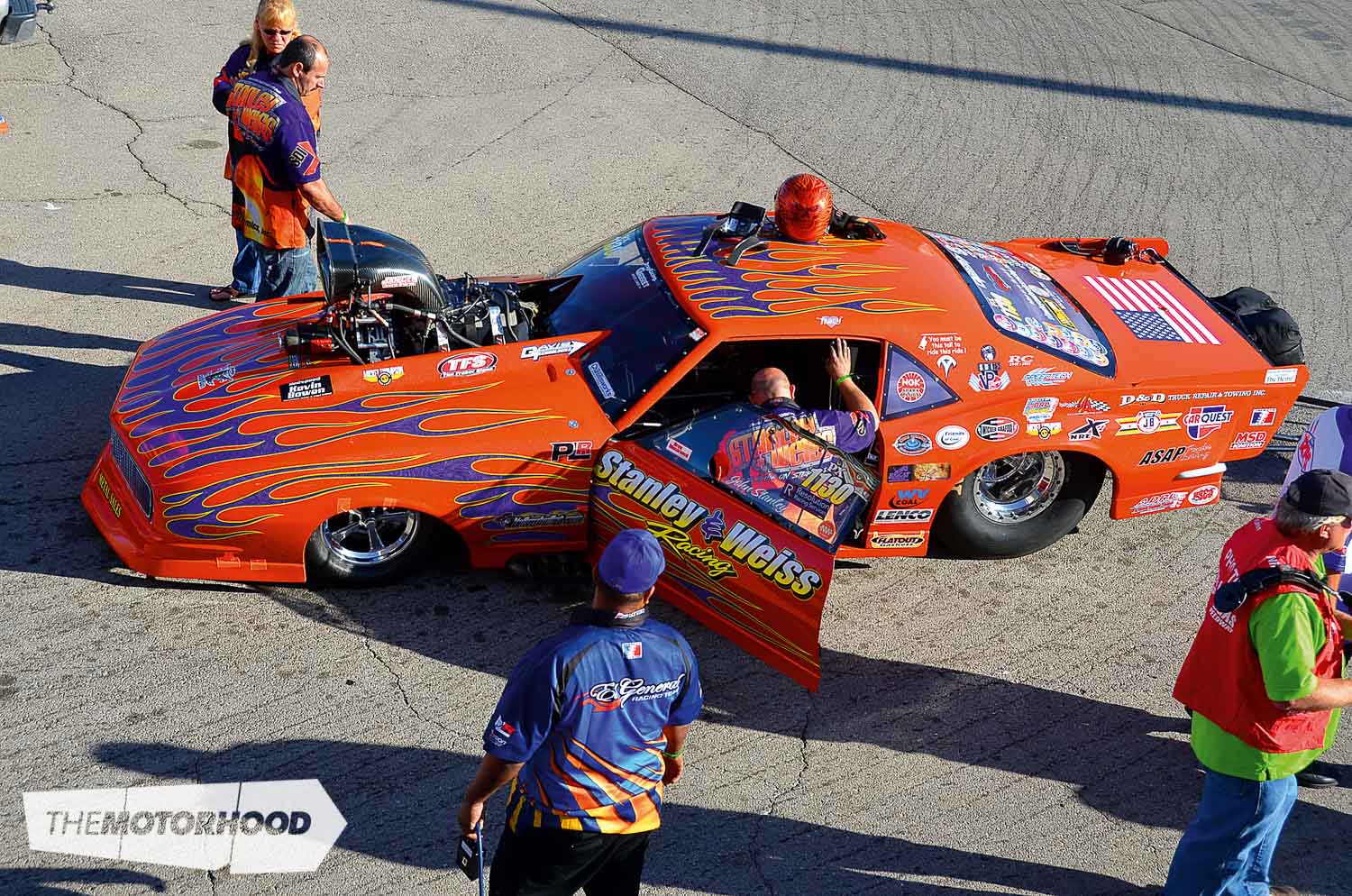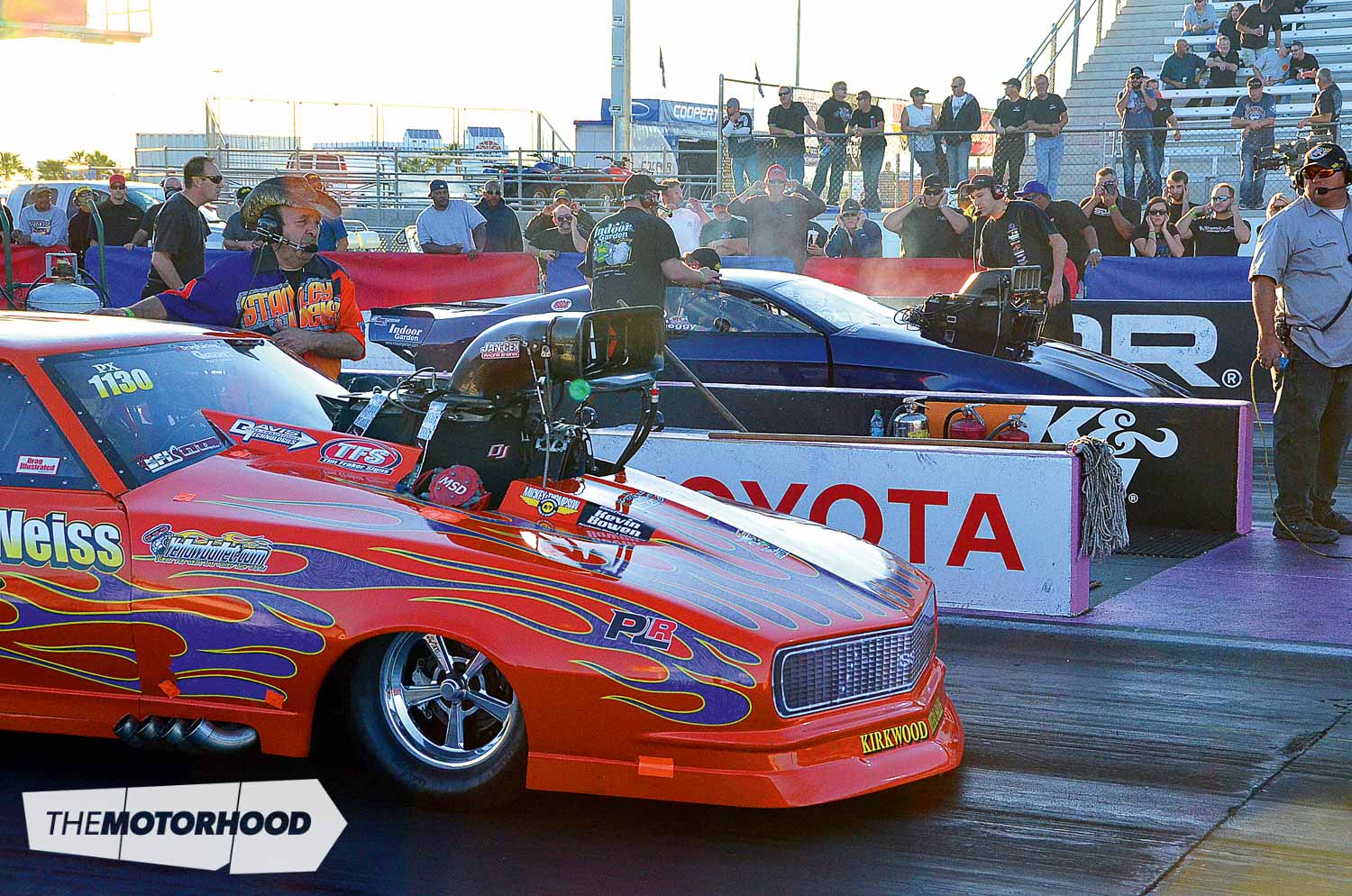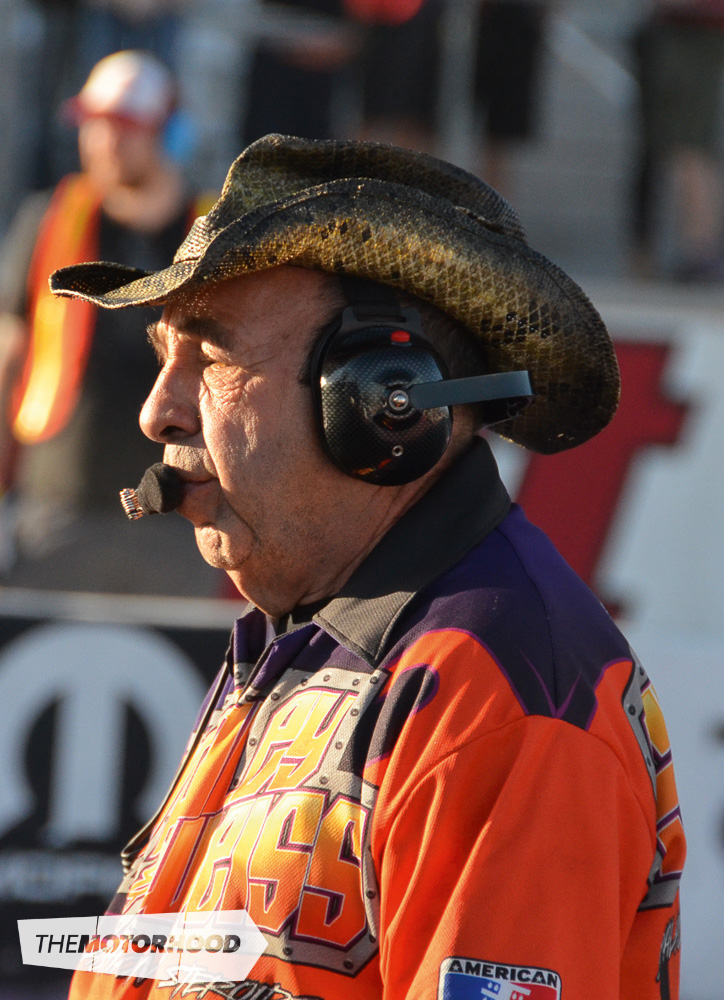
data-animation-override>
“Founding father of the ‘Wild Bunch’, Godfather of Pro Modified, and outrageous character — the US’s Arthur Camp Stanley the Third needs no introduction to many New Zealand drag racers”
It seems forever ago — sometime in 1988 — that I was sitting in my home town Wanganui, just before my move to the big smoke of Auckland, reading the latest edition of American Super Stock & Drag Illustrated magazine, captivated by an article entitled ‘The Making of Flight 699’ — an amazing story that recorded in detail the seemingly unbelievable feat of a supercharged sedan breaking the seven-second barrier at Atco Raceway in the US, and running the world’s first six-second doorslammer pass at over 200mph.

I was mesmerized; here in New Zealand in early 1988, no one had even thought of putting a top alcohol racing engine into a sedan. Top alcohol dragsters and funny cars were running sevens (some Kiwi alcohol dragster teams were only just dipping into the sevens that year), and the only car in New Zealand running six-second passes was Garth Hogan’s top fuel dragster. So, to read about a full-bodied Nissan 300ZX sedan fitted with a supercharged, all-steel, big block Chevy engine doing what our top alcohol cars couldn’t do with all-aluminium Keith Black racing engines really got my attention.

The car’s owner and driver was Tommy Howes, and it was hard not to notice the name of the other side of the partnership, the person who supplied the engine and the tuning for the world-breaking feat: Camp Stanley. It should, of course, be pointed out that ‘camp’ doesn’t mean in the US what it sometimes means here; when Camp later raced his Ford Taurus station wagon ‘Wild Bunch’ car in Australia, he was mocked mercilessly by the Aussies. He hastily had some signwriting made up to precede his name on each side of his car; it read: I am not … Clearly, despite his unfortunate name (Down Under, at least), Camp Stanley was a very clever man.

Only two or three years later, I was living in Auckland and working for New Zealand Hot Rod magazine when Chris Tynan spectacularly broke all the rules here in New Zealand for sedan-bodied drag cars — along with the eight-second barrier — by fitting a supercharged engine to his much-loved ’55 Chevy ‘Rat Attack’, and, in the process, capturing the heart of every Kiwi drag racing fan with never-before-seen full-track burnouts and the very first seven-second pass for a full-bodied sedan in New Zealand. I detailed Chris’s groundbreaking and trend-setting achievement in an article in New Zealand Hot Rod that explored how it all came together, and entitled it (most unoriginally, I fully admit!) ‘The Making of Flight 799’.
The connection to the clever guy with the funny name happened right after that, when Chris started upping the stakes in his efforts to go ever faster in the ’55, as a small army of drag racers who had been inspired by Chris and Rat Attack gave chase to what would become a seemingly impenetrable reign over the kingdom of Wild Bunch racing for a number of years. Chris had discovered Camp Stanley as a seller of the second-hand parts that he needed in order to remain head of his kingdom. Once the relationship between the two of them was established, Camp would often stop over in New Zealand on his way to Australia, with suitcases splitting at the seams from the burden of carrying aluminium cylinder heads and superchargers and crankshafts and injector hats (some of these bags travelling in the aircraft’s overhead lockers above his seat!), all of which would be unloaded with great expectation and excitement onto the Tynan dining table.

As luck would have it for me, I was in Matamata a lot in those days. Chris was helping us with the injected big block Chev-engined dragster that we were running in the early ’90s, and, through my friendship with Chris, I also formed a friendship with Camp — Arthur Camp Stanley the Third, to be precise — that has lasted to this day.
Over the next decade and a half, Camp became a loud and colourful part of the New Zealand drag racing landscape, bringing his massive bank of experience and knowledge with him, first to help Chris understand the nuances of running and tuning top doorslammer racing engines, then to guide Dave Green’s top doorslammer Corvette towards its record-setting 6.40-second pass back whenever that was, and after that to help Tim Watkins assemble the necessary equipment to run New Zealand’s first-ever five-second alcohol funny car pass.
As Camp became known to Kiwi drag racers, he began to be called over to first this pit space then that pit space, and he’d happily help anyone willing to slip their ego quietly into their toolbox for a few minutes and ask for his boundless advice. During those years, Camp Stanley — a guy nothing short of famous in American drag racing circles — wandered about our New Zealand staging lanes and pit areas, held in awe by a few and unrecognized by most.
A proper pen-portrait of Camp can’t be achieved quickly, but he’s generally acknowledged throughout the US as one of the pioneers — if not the pioneer — of the concept of supercharged sedans. Camp started out with a 6-71 supercharged ’68 Chevy Camaro street car that turned 8.5-second quarter-mile passes back in 1979 — an accomplishment that most of us would be proud to achieve 35 years later. The Camaro (a licence plate from which adorns my garage wall) was replaced by a blown and injected alcohol-burning Chevy LUV truck (think Datsun B1600 ute, if you’re old enough), then followed by the Ford Taurus wagon in which he ran seven-second passes, match-racing Tommy Howes all over the East Coast of America during the 1980s. In the process, he ignited the whole Wild Bunch frenzy, which later evolved into what we now know as ‘Pro Modified’ cars. Many call him the Godfather of Pro Modified.
After Camp’s short-but-successful pairing with Tommy Howes to record the world’s first six-second sedan pass with the Nissan 300ZX in 1988, running in the sixes at over 200mph soon become standard fare in his own Ford Taurus wagon, and Camp and Tommy took their cars to Australia to match-race, successfully spreading the Wild Bunch message over there.
In the early 1990s, with a growing family and limited income, Camp retired from the driving seat and sold up, and instead chose to spend his time helping the likes of Chris and Dave and many others here in New Zealand, as well as other doorslammer racers throughout America, Australia, Canada, England, Germany, and even South Africa.

‘Keen’ doesn’t even begin to describe Camp Stanley’s love of drag racing, his seemingly limitless energy, and his burning desire to help others. I quizzed Camp once on what it takes to get here from the eastern side of the US, and he ran through one typical trip when he flew to New Zealand to help Dave Green race at Masterton one weekend. Take a deep breath! Camp left his home in Hagerstown, Maryland (which is near Washington City on the East Coast) at 9am, drove two hours to Baltimore, departed Baltimore airport at 1pm, arriving at Philadelphia (Pennsylvania) airport at 2pm. He departed Philadelphia at 3.30pm for a five-hour flight to Los Angeles, arriving (three-hour time difference) in Los Angeles at 6pm. He departed Los Angeles at 9.30pm to spend another 12.5 hours flying to Auckland, arriving at (a time-corrected) 6am, then departed Auckland at 9am to arrive in Wellington at 10am. Actual travel time: 31 hours.
Upon arrival in Wellington at 10am on the Friday before the race meeting in Masterton, Camp was whisked back to Dave’s, where he got straight into overseeing the preparation of the Corvette. He did that all day Friday, followed by late-night partying with Dave and his crew (as Camp can’t not do), then spent a long, hard, hot weekend helping Dave with running and tuning the car. ‘Jetlag’ isn’t in Camp’s vocabulary. Monday morning, and it’s 31 hours back home again, arriving at 2.30am Wednesday. Two days later, and Camp’s driving back to the Baltimore airport to fly to Australia to help Sean Misfud run his ’41 Willys coupe top doorslammer. Not bad for anyone, let alone someone receiving the government pension.
“You’re f*****g nuts,” I told him. “Why didn’t you just hang out down here for a few days?”
“I had stuff to do back home,” was the reply. “Besides, you know I hate just sitting around.”
Which is right — this five-foot–bugger-all jackhammer isn’t at all good at relaxing.
During most of Camp’s trips to New Zealand to help Chris or Dave or whoever else (he was no help to me with my Hell Pizza ’56 Chevy because “What the f**k would I know about that thing? It’s near on 40 years since I had a car with a carburettor!”), he’d spend a night at our place in rural South Auckland. Camp would, without fail, drink far too much and provide huge entertainment for us and everyone else who would want to come over and hang out with the loveable and noisy dynamo whenever he stayed. One time, we noticed during the latter part of dinner that our Bernese Mountain Dog was acting a little more weirdly than normal and Camp was churning through the wine even more swiftly than usual. We eventually discovered that he was alternating between drinking from his wine glass and covertly holding it under the table so as to allow our dog to share it with him. She loved the wine nearly as much as she loved its provider, and when she licked Camp’s face every morning to wake him up, Camp would just open his eyes, give her a big hug, and lick her furry pretty face right back.

During Camp’s retirement as a car owner and driver, his boys grew up, and with son John showing both interest in and ability behind the wheel of a drag car, Camp was soon back into owning his own racer but this time with John behind the wheel. John’s driving developed alongside Camp’s trademark bright-orange-with-purple-flames Chevy Camaro top doorslammer, and the father and son Stanleys have spent the past six or so years battling it out in the highly competitive American Drag Racing League (ADRL) series, which runs eighth-mile tracks all over the eastern side of the Mississippi River.
The Stanley and Weiss Racing Team — the ‘Weiss’ part of it being Camp’s long-time good friend and racing partner ‘Axle’ Weiss — has been a great ‘little guy’ story of a small team from the Appalachian Mountains on a tight budget taking the fight to the big dogs, along the way experiencing ups, downs, wins, losses, and plenty of breakages in their untiring and determined quest to slug it out, punch by punch, to the top of the pile.
Whichever of the many ways that a day of running these fragile missiles can go, Camp’s passionate, positive, larger-than-life, and generally outrageous character always remains intact. We stayed with Camp at his home in Hagerstown, Maryland, a decade ago and saw first-hand that these guys operate — swankier tow rig aside — just like most of us do. Everything happens in a regular double garage; every purchase is carefully considered; nothing happens without a lot of hard work; and John is quick to lift at the first sign of trouble because there are no spare engines in the trailer.
The car has evolved over a number of years like grandad’s axe — it’s the same old axe, but none of the current Camaro was fitted to the race car from which it began. Today, the Stanley and Weiss team is a fiercely competitive force within the ADRL, consistently running the eighth-mile in 3.6 seconds, with a best of 3.59 seconds and speeds (for just half of a quarter-mile, remember) of over 210 mph. And now, at just one year short of 70 years of age, there’s still a lot of fight in the old dog.
Late last year, Camp Stanley and his driver and team did something very, very special. Given his unofficial status as an honorary New Zealand drag racer, it’s well worth telling you about. And we’ll do that next month …
This article originally appeared in NZV8 Issue No. 110. Don’t miss out on adding this issue to your collection. Grab a print copy or a digital copy below:











